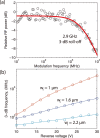High-Q CMOS-integrated photonic crystal microcavity devices
- PMID: 24518161
- PMCID: PMC3921634
- DOI: 10.1038/srep04077
High-Q CMOS-integrated photonic crystal microcavity devices
Abstract
Integrated optical resonators are necessary or beneficial in realizations of various functions in scaled photonic platforms, including filtering, modulation, and detection in classical communication systems, optical sensing, as well as addressing and control of solid state emitters for quantum technologies. Although photonic crystal (PhC) microresonators can be advantageous to the more commonly used microring devices due to the former's low mode volumes, fabrication of PhC cavities has typically relied on electron-beam lithography, which precludes integration with large-scale and reproducible CMOS fabrication. Here, we demonstrate wavelength-scale polycrystalline silicon (pSi) PhC microresonators with Qs up to 60,000 fabricated within a bulk CMOS process. Quasi-1D resonators in lateral p-i-n structures allow for resonant defect-state photodetection in all-silicon devices, exhibiting voltage-dependent quantum efficiencies in the range of a few 10 s of %, few-GHz bandwidths, and low dark currents, in devices with loaded Qs in the range of 4,300-9,300; one device, for example, exhibited a loaded Q of 4,300, 25% quantum efficiency (corresponding to a responsivity of 0.31 A/W), 3 GHz bandwidth, and 30 nA dark current at a reverse bias of 30 V. This work demonstrates the possibility for practical integration of PhC microresonators with active electro-optic capability into large-scale silicon photonic systems.
Figures




References
-
- Vahala K. J. Optical microcavities. Nature 424, 839–846 (2003). - PubMed
-
- Little B. E., Chu S. T., Haus H. A., Foresi J. & Laine J.-P. Microring resonator channel dropping filters. IEEE J. Lightwave Tech. 15, 998–1005 (1997).
-
- Xu Q., Schmidt B., Pradhan S. & Lipson M. Micrometre-scale silicon electro-optic modulator. Nature 435, 325–327 (2005). - PubMed
-
- Noda S., Fujita M. & Asano T. Spontaneous-emission control by photonic crystals and nanocavities. Nature Photon. 1, 449–458 (2007).
-
- Akahane Y., Asano T., Song B.-S. & Noda S. High-Q photonic nanocavity in a two-dimensional photonic crystal. Nature 425, 944–947 (2003). - PubMed
Publication types
LinkOut - more resources
Full Text Sources
Other Literature Sources

